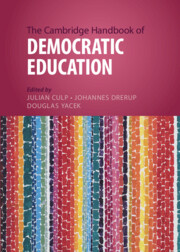Book contents
- The Cambridge Handbook of Democratic Education
- Cambridge Handbooks in Education
- The Cambridge Handbook of Democratic Education
- Copyright page
- Contents
- Contributors
- Acknowledgments
- Introduction
- Part One Historical Perspectives
- Part Two Philosophical and Normative Foundations
- Part Three Key Topics and Concepts
- Part Four Challenges
- 26 Wealth Stratification in US Higher Education and Democratic Education, 1890s–2020s
- 27 Mentoring and Instructional Duties of Professors
- 28 Racism, Moral Transformation, and Democratic Education
- 29 Postcolonial Perspectives on Democratic Education
- 30 Populist Challenges to Democratic Education
- 31 Religion and Democratic Education
- 32 The Epistocratic Challenge to Democratic Education
- 33 Climate Change and Democratic Education
- 34 The COVID-19 Pandemic and Democratic Education
- 35 Teacher Neutrality, Pedagogical Impartiality, and Democratic Education
- Index
- References
26 - Wealth Stratification in US Higher Education and Democratic Education, 1890s–2020s
from Part Four - Challenges
Published online by Cambridge University Press: 20 April 2023
- The Cambridge Handbook of Democratic Education
- Cambridge Handbooks in Education
- The Cambridge Handbook of Democratic Education
- Copyright page
- Contents
- Contributors
- Acknowledgments
- Introduction
- Part One Historical Perspectives
- Part Two Philosophical and Normative Foundations
- Part Three Key Topics and Concepts
- Part Four Challenges
- 26 Wealth Stratification in US Higher Education and Democratic Education, 1890s–2020s
- 27 Mentoring and Instructional Duties of Professors
- 28 Racism, Moral Transformation, and Democratic Education
- 29 Postcolonial Perspectives on Democratic Education
- 30 Populist Challenges to Democratic Education
- 31 Religion and Democratic Education
- 32 The Epistocratic Challenge to Democratic Education
- 33 Climate Change and Democratic Education
- 34 The COVID-19 Pandemic and Democratic Education
- 35 Teacher Neutrality, Pedagogical Impartiality, and Democratic Education
- Index
- References
Summary
Higher education in the United States advanced democracy during the much of the twentieth century by fostering social mobility and by deepening students’ understanding of democratic citizenship, as well as strengthening their capacity to participate in a democratic polity. Concurrently, higher education enjoyed widespread esteem in the United States, while colleges and universities became highly stratified by financial capital, or endowment size, which was closely correlated with prestige. Yet, this financial stratification widened into a yawning "wealth gap" that precipitated a decline in public esteem near the end of the twentieth century. This historical chapter explains these developments and argues that wealth concentration in higher education and wealth inequality in the US population are interrelated, and this interrelationship weakens social mobility and democracy in the twenty-first century.
Keywords
- Type
- Chapter
- Information
- The Cambridge Handbook of Democratic Education , pp. 435 - 455Publisher: Cambridge University PressPrint publication year: 2023
References
- 1
- Cited by



